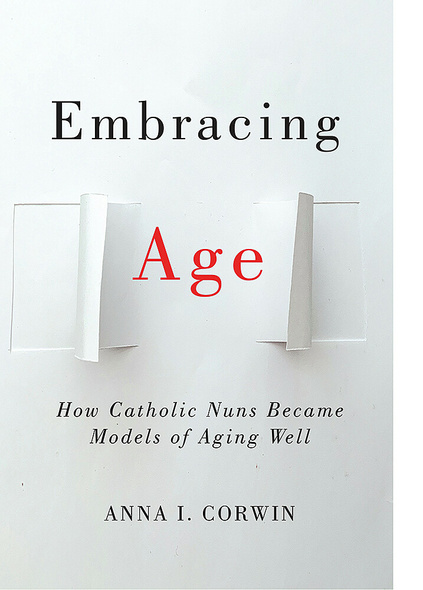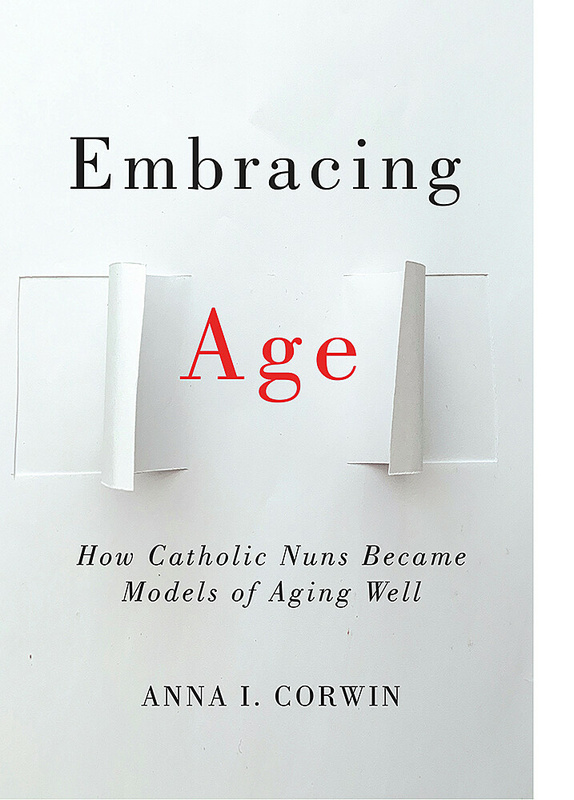
202 pages, 6 x 9
12 b-w images, 6 tables
Paperback
Release Date:13 Aug 2021
ISBN:9781978822276
Hardcover
Release Date:13 Aug 2021
ISBN:9781978822283
Embracing Age
How Catholic Nuns Became Models of Aging Well
SERIES:
Global Perspectives on Aging
Rutgers University Press
Embracing Age: How Catholic Nuns Became Models of Aging Well examines a community of individuals whose aging trajectories contrast mainstream American experiences. In mainstream American society, aging is presented as a “problem,” a state to be avoided as long as possible, a state that threatens one’s ability to maintain independence, autonomy, control over one’s surroundings. Aging “well” (or avoiding aging) has become a twenty-first century American preoccupation. Embracing Age provides a window into the everyday lives of American Catholic nuns who experience longevity and remarkable health and well-being at the end of life. Catholic nuns aren’t only healthier in older age, they are healthier because they practice a culture of acceptance and grace around aging. Embracing Age demonstrates how aging in the convent becomes understood by the nuns to be a natural part of the life course, not one to be feared or avoided. Anna I. Corwin shows readers how Catholic nuns create a cultural community that provides a model for how to grow old, decline, and die that is both embedded in American culture and quite distinct from other American models.
Instructor's Guide is available at no cost (https://d3tto5i5w9ogdd.cloudfront.net/wp-content/uploads/2021/08/26120146/corwin_instructor_guide_final.pdf).
Open access edition funded by the National Endowment for the Humanities.
The text of this book is licensed under a Creative Commons Attribution NonCommercial-NoDerivatives 4.0 International License: https://creativecommons.org/licenses/by-nc-nd/4.0/
Download open access ebook here.
Instructor's Guide is available at no cost (https://d3tto5i5w9ogdd.cloudfront.net/wp-content/uploads/2021/08/26120146/corwin_instructor_guide_final.pdf).
Open access edition funded by the National Endowment for the Humanities.
The text of this book is licensed under a Creative Commons Attribution NonCommercial-NoDerivatives 4.0 International License: https://creativecommons.org/licenses/by-nc-nd/4.0/
Download open access ebook here.
The question of why and how religious commitment seems to improve the body’s health is one of the deepest puzzles in social science. Embracing Age suggests that one answer lies in the way people of faith use language to describe their lives and worlds. This beautifully written book will change the way you think about aging.
The modern world urges us to outrun age, numb pain, and ignore death, but perhaps the secret to longevity and contentedness lies within the walls of a convent, where nuns practice a timeless model of gracious living. Anna Corwin, with a novitiate’s curiosity and an anthropologist’s precision, investigates the source of nuns’ grace and sparkle—and presents it as something we can tap into, too.
Corwin’s lush ethnography of convent life unlocks how elderly nuns experience aging in ways that render them healthier and happier than those of us who have taken a secular path. Embracing Age brings readers into nuns’ daily spiritual (intercessory prayers) and peer support (pastoral visits to the infirm). Observations, in-depth interviews, and clinical health measures are brought together to illuminate nuns’ sense of the life-death transition.
In Embracing Age, Anna Corwin tells us of aging and death through the eyes and experiences of American Catholic nuns. It is revealing, enlightening, a balm for those contemplating what is too often thought of as the pain and indignity of old age. The remarkable part, though, is how much it tells of life itself, and the things that really matter.
Embracing Age is a sensitive and illuminating study of the pro-aging alternative offered by Catholic nuns. Through their emphasis on the interdependence of life and the value they place on 'being' rather than 'doing,' the nuns demonstrate a culture of acceptance and grace that can inspire us all.
Embracing Age reveals the ways in which the culture of American convents embraces aging as a positive process, providing sustenance for mind, body, and spirit. Vividly written, this book brings the reader deep into nuns' everyday experiences of life. Astute and accessible, it will be valuable reading for anyone interested in alternative age-positive ways of living and being.
Anna Corwin on her book, Embracing Aging
[Corwin's] deeply researched book is a model of scholarship while also engaging nonacademic readers as well with its insightful and eloquent portrayal of convent life.
Catholic nuns are role models for long and productive lives,' by Marlene A. Zloza
Anna Corwin’s book, Embracing Age invites us to ponder some very important questions: What does it mean to be old? What is the meaning in diminishment? How can we all 'do' this human process of aging best?...Perhaps the most potent take-away or 'secret' of aging is, as the book title asserts, not to avoid but to embrace aging.
This synthetic work culminates Corwin’s previous publications into a central claim that anthropological methods and theory illuminate the way nuns socially and linguistically embrace age to experience well-being despite age-related decline. The compelling applicability of Corwin’s conclusions make Embracing Age a critical read for social scientists, clinicians, and thoughtful humans alike. In a society obsessed with ‘successful aging,’ but caught in a paradox that inhibits its realization, scholars like Corwin serve as trustworthy guides as they blend humanities and science into works of vital significance.
The question of why and how religious commitment seems to improve the body’s health is one of the deepest puzzles in social science. Embracing Age suggests that one answer lies in the way people of faith use language to describe their lives and worlds. This beautifully written book will change the way you think about aging.
The modern world urges us to outrun age, numb pain, and ignore death, but perhaps the secret to longevity and contentedness lies within the walls of a convent, where nuns practice a timeless model of gracious living. Anna Corwin, with a novitiate’s curiosity and an anthropologist’s precision, investigates the source of nuns’ grace and sparkle—and presents it as something we can tap into, too.
Corwin’s lush ethnography of convent life unlocks how elderly nuns experience aging in ways that render them healthier and happier than those of us who have taken a secular path. Embracing Age brings readers into nuns’ daily spiritual (intercessory prayers) and peer support (pastoral visits to the infirm). Observations, in-depth interviews, and clinical health measures are brought together to illuminate nuns’ sense of the life-death transition.
In Embracing Age, Anna Corwin tells us of aging and death through the eyes and experiences of American Catholic nuns. It is revealing, enlightening, a balm for those contemplating what is too often thought of as the pain and indignity of old age. The remarkable part, though, is how much it tells of life itself, and the things that really matter.
Embracing Age is a sensitive and illuminating study of the pro-aging alternative offered by Catholic nuns. Through their emphasis on the interdependence of life and the value they place on 'being' rather than 'doing,' the nuns demonstrate a culture of acceptance and grace that can inspire us all.
Embracing Age reveals the ways in which the culture of American convents embraces aging as a positive process, providing sustenance for mind, body, and spirit. Vividly written, this book brings the reader deep into nuns' everyday experiences of life. Astute and accessible, it will be valuable reading for anyone interested in alternative age-positive ways of living and being.
Anna Corwin on her book, Embracing Aging
[Corwin's] deeply researched book is a model of scholarship while also engaging nonacademic readers as well with its insightful and eloquent portrayal of convent life.
Catholic nuns are role models for long and productive lives,' by Marlene A. Zloza
Anna Corwin’s book, Embracing Age invites us to ponder some very important questions: What does it mean to be old? What is the meaning in diminishment? How can we all 'do' this human process of aging best?...Perhaps the most potent take-away or 'secret' of aging is, as the book title asserts, not to avoid but to embrace aging.
This synthetic work culminates Corwin’s previous publications into a central claim that anthropological methods and theory illuminate the way nuns socially and linguistically embrace age to experience well-being despite age-related decline. The compelling applicability of Corwin’s conclusions make Embracing Age a critical read for social scientists, clinicians, and thoughtful humans alike. In a society obsessed with ‘successful aging,’ but caught in a paradox that inhibits its realization, scholars like Corwin serve as trustworthy guides as they blend humanities and science into works of vital significance.
ANNA I. CORWIN is an associate professor of anthropology at Saint Mary's College of California in Moraga.
List of Illustrations
Introduction
Part I Being Well in the Convent: Prayer and Care in Interaction
1 Life in the Convent
2 Being Is Harder Than Doing: The Process of Embracing Aging
3 Talking to God: Prayer as Social Support
4 Care, Elderspeak, and Meaningful Engagement
Part II Shaping Experience: The Convent in Sociohistorical Context
5 Changing God, Changing Bodies: How Prayer Practices Shape Embodied Experience
6 Spiritual Healing, Meaningful Decline, and Sister Death
7 Kenosis: Emptying the Self
Conclusion
Appendix: Transcription Conventions
Acknowledgments
Notes
References
Index
Introduction
Part I Being Well in the Convent: Prayer and Care in Interaction
1 Life in the Convent
2 Being Is Harder Than Doing: The Process of Embracing Aging
3 Talking to God: Prayer as Social Support
4 Care, Elderspeak, and Meaningful Engagement
Part II Shaping Experience: The Convent in Sociohistorical Context
5 Changing God, Changing Bodies: How Prayer Practices Shape Embodied Experience
6 Spiritual Healing, Meaningful Decline, and Sister Death
7 Kenosis: Emptying the Self
Conclusion
Appendix: Transcription Conventions
Acknowledgments
Notes
References
Index





